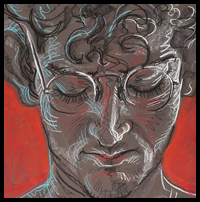How To Capture Someone's Likeness In A Drawing
Have you ever tried to capture someone's likeness in a drawing, but struggled to make it look like them? It can be frustrating to put in the time and effort to create a portrait, only to have it fall short of your expectations. But fear not, because we've compiled some tips and tricks on how to capture someone's likeness in a drawing.
The Struggle of Capturing a Likeness
When it comes to drawing portraits, one of the biggest struggles is capturing the likeness of the subject. Whether it's the shape of their face, the angle of their eyes, or the curve of their lips, there are many small details that can make or break the likeness in your drawing. The frustration of not being able to accurately capture someone's appearance can cause some artists to give up on portraiture altogether.
Tips for Capturing a Likeness
First and foremost, it's important to take your time when drawing a portrait. Rushing through the process can lead to mistakes and inaccuracies. Start by sketching lightly and making sure the proportions are correct before adding in any details.
Another helpful tip is to pay attention to the unique features of the subject's face. Is their nose especially prominent? Do they have a distinct jawline? Taking note of these details and incorporating them into your drawing can make all the difference in capturing a likeness.
Additionally, using reference photos or even having the subject sit for a live drawing session can be incredibly helpful in capturing a likeness. Being able to study the subject's face from different angles and lighting situations can give you a better understanding of their features and help you recreate them on paper.
Main Points for Capturing a Likeness
When it comes to capturing a likeness in a drawing, it's important to take your time, pay attention to details, and use reference materials to your advantage. By following these tips and tricks, you can improve your portraiture skills and create stunning drawings that truly capture the essence of your subject.
Breaking Down the Process
When it comes to capturing someone's likeness in a drawing, one approach is to break down the process into smaller, more manageable steps. For example, start by sketching out the overall shape of the face before moving onto specific features like the eyes and nose. This can help you stay focused and avoid getting overwhelmed by all the different elements in a portrait.
Another helpful technique is to use basic shapes to map out the features of the face. For example, you might use a circle for the head, ovals for the eyes, and triangles for the nose and mouth. This can help you establish the correct proportions and ensure that everything is in the right place before adding in more details.
Getting the Right Tools
In addition to these techniques, it's important to have the right tools at your disposal when trying to capture a likeness in a drawing. This might include high-quality pencils, erasers, and paper, as well as reference photos or a mirror to study your own facial features.
It's also worth investing in a good quality drawing tablet or software if you prefer to work digitally. These tools can make it easier to adjust and refine your drawings as you work, and offer a range of helpful features like layering and color palettes.
The Importance of Practice
Ultimately, the key to capturing a likeness in a drawing is practice. Like any skill, it takes time and effort to master the techniques and develop an eye for detail. Don't be discouraged if your early attempts don't turn out the way you want them to - every drawing is a learning experience, and each one will bring you one step closer to achieving the perfect likeness.
Question and Answer
Q: How can I improve my portrait drawing skills?
A: The best way to improve your portrait drawing skills is through practice. Set aside time each day to work on your drawings, and experiment with different techniques and materials to see what works best for you.
Q: How important is it to use reference materials when drawing portraits?
A: Using reference materials, whether it's a photo or a live model, can be incredibly helpful in capturing a likeness. It allows you to study the subject's face in different lighting and angles, and can give you a better understanding of their unique features.
Q: Do I need to have formal art training to be able to draw portraits?
A: While formal training can be helpful, it's not necessary to be able to draw portraits. With practice and dedication, anyone can develop the skills to create stunning portraits.
Q: How can I avoid getting discouraged when my portrait drawings don't turn out the way I want them to?
A: Remember that every drawing is a learning experience, and that it takes time and effort to develop your skills. Instead of focusing on the end result, try to enjoy the process of creating and experimenting, and use each drawing as an opportunity to grow and improve.
Conclusion
While capturing someone's likeness in a drawing can be a challenge, it's also a deeply rewarding experience. By taking your time, paying attention to details, and using reference materials to your advantage, you can improve your portraiture skills and create stunning drawings that truly capture the essence of your subject.
Gallery
Capture A Likeness In Drawing Portraits - YouTube

Photo Credit by: bing.com /
How To Capture A Likeness When Drawing People's Faces In Portraits

Photo Credit by: bing.com / likeness drawing rough capture portraits life draw capturing likness
How To Get A LIKENESS In A Portrait | Sketching & Drawing In 2019

Photo Credit by: bing.com / likeness portrait
The Simple Way To Easily Capture A Likeness And Do Better Drawings Now

Photo Credit by: bing.com / likeness
How To Draw Someone's Likeness? - YouTube

Photo Credit by: bing.com / likeness